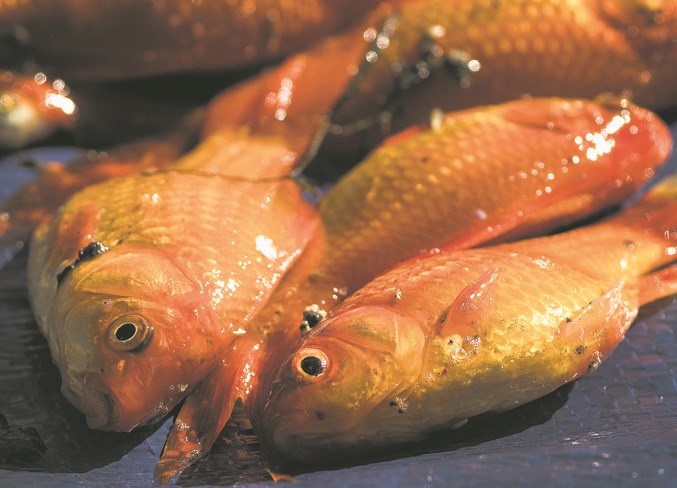Lacombe Lake Park will soon be the site of a mass fish kill as the city tries to exterminate its last known population of invasive goldfish.
St. Albert environment manager Christian Benson confirmed this week that city crews would apply the pesticide Rotenone to Lacombe Lake in the first week of September to kill off the lake’s population of invasive goldfish. A second application will follow in late September.
Goldfish are not native to Alberta and can grow huge in the wild, threatening native fish. Many jurisdictions are struggling to evict them from their storm-water ponds before they invade local lakes and rivers.
The city first learned it had an invasive goldfish problem in 2015 when hundreds of them were spotted in Edgewater Pond and Ted Hole Park. Last year, on the advice of Alberta Environment, city crews treated both lakes with Rotenone, killing roughly 45,000 goldfish, Benson said. Some of those fish were 10 inches long.
Goldfish have been in Lacombe Lake Park since at least 1999, the Gazette’s archives suggest. As the lake has no direct connection to the Sturgeon River, there was some debate as to whether or not the fish there posed any environmental threat.
The new nearby Riverside storm-water pond does link to the Sturgeon, however, which creates the risk that a bird or person could move a goldfish from Lacombe to Riverside and into the river, Benson said. That risk, plus the fact that the fish is invasive, led the city and province to decide to purge Lacombe Lake.
“The lake has been identified as containing a prohibited invasive species,” Benson said, so the city is obliged under provincial law to eliminate the fish.
Residents should expect to see boats and people wearing backpacks and protective gear pumping Rotenone into the lake for about four hours sometime during the week of Sept. 4, Benson said. This may turn the water cloudy white and produce a mothball-like smell. Parts of the local bike path will be fenced off as this occurs. Crews will then fence off the entire lake for 72 hours, during which they will collect any dead fish that turn up.
“We do expect several thousand fish,” Benson said, adding that residents should not collect any dead fish.
Benson acknowledged that the Rotenone would likely kill off the lake’s crayfish, which are also invasive. It could also take out any trout stocked there by the Alberta Conservation Association, but losses are expected to be minimal, as the lake was not stocked last year. The association plans to add more trout to the lake next year.
The lake will be safe to use after the fences come down, as Rotenone only affects creatures with gills and breaks down completely in six days, Benson said. Crews did not observe any impacts on fish-eating birds during the Ted Hole and Edgewater applications. A bird would have to eat about 40 pounds of Rotenone-treated creatures in a day before receiving a lethal dose, a FAQ published by the city said.
Benson said Alberta Environment was covering the cost of this Rotenone application.
“These are the kinds of things that can be avoided,” he noted.
Benson reminded residents not to release goldfish or other non-native fish species into local lakes and rivers or flush them down the toilet, and to thoroughly clean their boats before leaving a lake.
St. Albert is monitoring the rest of its lakes for goldfish, but has yet to find any, Benson said.
“This is a really widespread issue,” he said, and the city has been getting many calls from other communities about how to manage goldfish.
Visit bit.ly/2MsS2AF for more on the goldfish campaign.




